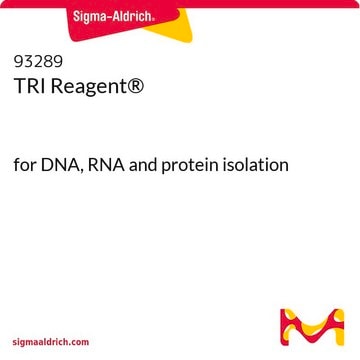R0901
RNAlater®
Stabilize and protect RNA with immediate RNase inactivation
Synonym(s):
RNA preservation solution, RNA protection solution, RNA protector, RNA stabilizer, RNA storage solution, RNA transportation solution
Sign Into View Organizational & Contract Pricing
All Photos(3)
About This Item
Recommended Products
Related Categories
General description
RNAlater is compatible with most RNA isolation methods, including TRI Reagent and GenElute Total RNA isolation and mammalian mRNA isolation kits.
RNAlater is an aqueous, non-toxic tissue storage reagent that rapidly permeates tissue to stabilize and protect cellular RNA in situ in unfrozen specimens. Tissue pieces are harvested and immediately submerged in RNAlater for storage without jeopardizing the quality or quantity of RNA. RNAlater eliminates the need to immediately process tissue specimens or to freeze samples in liquid nitrogen for later processing. RNAlater preserves RNA in tissues for up to 1 day at 37 °C, 1 week at 25 °C, and 1 month at 4 °C. Tissues can also be stored at -20 °C long-term.
RNAlater has been extensively tested on several tissues from vertebrate species, including brain, heart, kidney, spleen, liver, testis, skeletal muscle, fat, lung, and thymus. RNAlater is also effective for E. coli, Drosophila, tissue culture cells, white blood cells, and some plants.
RNAlater is an aqueous, non-toxic tissue storage reagent that rapidly permeates tissue to stabilize and protect cellular RNA in situ in unfrozen specimens. Tissue pieces are harvested and immediately submerged in RNAlater for storage without jeopardizing the quality or quantity of RNA. RNAlater eliminates the need to immediately process tissue specimens or to freeze samples in liquid nitrogen for later processing. RNAlater preserves RNA in tissues for up to 1 day at 37 °C, 1 week at 25 °C, and 1 month at 4 °C. Tissues can also be stored at -20 °C long-term.
RNAlater has been extensively tested on several tissues from vertebrate species, including brain, heart, kidney, spleen, liver, testis, skeletal muscle, fat, lung, and thymus. RNAlater is also effective for E. coli, Drosophila, tissue culture cells, white blood cells, and some plants.
RNAlater can be used with various downstream applications including mRNA and total RNA isolation, histology and immunocytochemistry and is compatible with Sigma′s isolation kits.
Application
RNAlater® has been used to synthesize antisense RNA probe. It can be used with various downstream applications including mRNA and total RNA isolation, histology and immunocytochemistry and is compatible with Sigma′s GenElute™ isolation kits.
Features and Benefits
- No compromise in RNA quality following mRNA or total RNA isolation
- Rapidly permeates tissues to stabilize and protect cellular RNA
- Aqueous non-toxic solution allows downstream tissue processing
- Stabilizes samples at room temperature
Other Notes
RNAlater® is an aqueous, non-toxic tissue and cell storage reagent that stabilizes and protects cellular RNA in intact, unfrozen tissue and cell samples. RNAlater eliminates the need to immediately process samples or to freeze samples in liquid nitrogen for later processing.
Principle
RNAlater is easy to use. Simply cut tissue samples to be stored so they are less than 0.5 cm in at least one dimension and submerge in 5 volumes of RNAlater. Small organs, such as rat kidney, liver or spleen can be stored in whole in RNAlater. When ready to isolate the RNA, remove the tissue from RNAlater and process as though just harvested. For cell storage, resuspend pelleted cells in a small amount of PBS before adding 5-10 volumes of RNAlater. Before preparing RNA, pellet cells and discard supernatant.
Legal Information
Licensed for distribution by Ambion, Inc., The RNA Company.
GenElute is a trademark of Sigma-Aldrich Co. LLC
RNAlater is a registered trademark of Ambion, Inc.
also commonly purchased with this product
Product No.
Description
Pricing
Storage Class Code
12 - Non Combustible Liquids
WGK
WGK 1
Flash Point(F)
Not applicable
Flash Point(C)
Not applicable
Certificates of Analysis (COA)
Search for Certificates of Analysis (COA) by entering the products Lot/Batch Number. Lot and Batch Numbers can be found on a product’s label following the words ‘Lot’ or ‘Batch’.
Already Own This Product?
Find documentation for the products that you have recently purchased in the Document Library.
Kazuhito Morioka et al.
Scientific reports, 9(1), 12199-12199 (2019-08-23)
Polytraumatic injuries, specifically long bone fracture and traumatic brain injury (TBI), frequently occur together. Clinical observation has long held that TBI can accelerate fracture healing, yet the complexity and heterogeneity of these injuries has produced conflicting data with limited information
The Wnt pathway regulator DKK1 is preferentially expressed in hormone-resistant breast tumours and in some common cancer types.
Forget MA
British Journal of Cancer, 96(4), 646-653 (2007)
Arabinda Mahanty et al.
BMC genomics, 18(1), 617-617 (2017-08-16)
High ambient temperature is known to affect fish gonadal development and physiology in a variety of ways depending on the severity and duration of exposure; however, the underlying molecular mechanisms are poorly understood. Gonadal gene expression influence the gonadal development
Emilia Sinderewicz et al.
Reproductive biology and endocrinology : RB&E, 15(1), 72-72 (2017-09-07)
Lysophosphatidic acid (LPA) regulates reproductive processes in the cow. Ovarian granulosa cells play a pivotal role in follicle growth and development. Nevertheless, the role of LPA in the local regulation of granulosa cell function in different follicle categories in the
Madson Silveira de Melo et al.
Environmental science and pollution research international, 26(21), 21535-21545 (2019-05-28)
Glyphosate-based herbicides (GBH) are the most used herbicides worldwide and are considered as endocrine-disrupting compounds (EDC) for non-target organisms. However, effects of GBH on their endocrine systems remain poorly understood. Thus, the aim of this study was to assess the
Our team of scientists has experience in all areas of research including Life Science, Material Science, Chemical Synthesis, Chromatography, Analytical and many others.
Contact Technical Service








